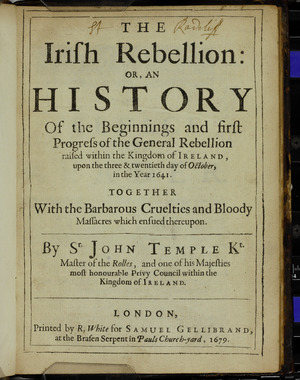John Temple (judge) facts for kids
Sir John Temple (born 1600 – died 1677) was an important lawyer and politician from Ireland. He served in the Irish Parliament and also in the English Parliament. He held a very important job called the Master of the Rolls in Ireland, which was like being a chief record keeper and judge.
Contents
Early Life and Education
John Temple was born in Ireland. His father, Sir William Temple, was the head of Trinity College Dublin, a famous university. John also studied at Trinity College Dublin. After his studies, he traveled to other countries. When he came back, he started working for King Charles I and was made a knight.
Working as a Lawyer and Politician
Sir John Temple returned to Ireland and, in 1640, he became the Master of the Rolls in Ireland. This meant he was in charge of keeping important government records and had judicial duties. He also joined the Privy Council of Ireland, a group of advisors to the King.
When the Irish Rebellion of 1641 started, Sir John helped the government by making sure the city of Dublin had enough supplies. In 1642, he was elected to the Irish House of Commons for County Meath.
Sir John tended to support the Parliament in England, which was having disagreements with King Charles. Because of this, in 1643, the King's representatives in Ireland suspended him from his job. He was even put in Dublin Castle with other important people. They were accused of writing letters that suggested the King was favoring the rebels.
After being in prison for about a year, he was released. In 1645, he was chosen to be a Member of Parliament for Chichester in the Long Parliament in England. This was seen as a way to make up for the unfair treatment he had received.
His Book: The Irish Rebellion
In 1646, Sir John Temple published a book called The Irish Rebellion. This book described the start of the rebellion in Ireland in 1641. It also talked about the violence that happened during that time.
The book became very popular and was believed by many people in Britain. It made many people feel angry towards the Irish. However, over time, many of the things he wrote were questioned. People started to see it more as a strong opinion piece than a completely accurate history book.
Some famous writers, like John Milton and Voltaire, who were against the Roman Catholic Church, praised Temple's book. But the Irish people were so upset by it that in 1689, the Patriot Parliament ordered the book to be publicly burned.
During the Interregnum
After peace was made between the King's supporters and Parliament in 1647, Sir John Temple was given new roles. He was appointed to help govern the region of Munster. In 1648, he was made a joint commissioner for the Great Seal of Ireland, which is used to make official documents valid.
However, he voted in favor of a compromise with King Charles, which went against the Parliament's wishes. Because of this, he was removed from Parliament during an event called Pride's Purge. For the next four years, he stayed out of public life and lived quietly in London.
In 1653, because of his personal experience with the Irish Rebellion, Sir John was asked to help decide who owned land in Ireland. He also helped figure out if people had supported the rebellion. After finishing this work, he returned to England in 1654.
He wanted to go back to his old job as Master of the Rolls. In 1655, he returned to Ireland with a strong recommendation from Oliver Cromwell, who was then the leader of England. He received a higher salary and grants of money for his special services. He also helped manage state lands and settle disagreements about land ownership.
The Restoration and Later Life
When Charles II became King in 1660 (an event known as the Restoration of Charles II), Sir John Temple was confirmed in his job as Master of the Rolls. He was also sworn in again as a member of the Privy Council.
In 1661, he was elected to represent County Carlow in the Irish Parliament, along with his eldest son, Sir William Temple, 1st Baronet. He received more land grants in Ireland over the years, including some near Phoenix Park and Chapelizod. In 1673, he was also made Vice-Treasurer of Ireland.
Sir John Temple passed away in 1677. He was buried next to his father at Trinity College. He left £100 to the college to help build new rooms for students. This gift allowed him and his family to choose two students to live in those rooms.
Family
Sir John Temple married Mary Hammond. She died in 1638. They had several children, including two sons and a daughter who died young. Their other children were:
- Sir William Temple, 1st Baronet: A very famous diplomat.
- Sir John Temple: Who later became the Attorney General for Ireland.
- Martha, Lady Giffard (1638-1722): She wrote about her brother William and his son.


